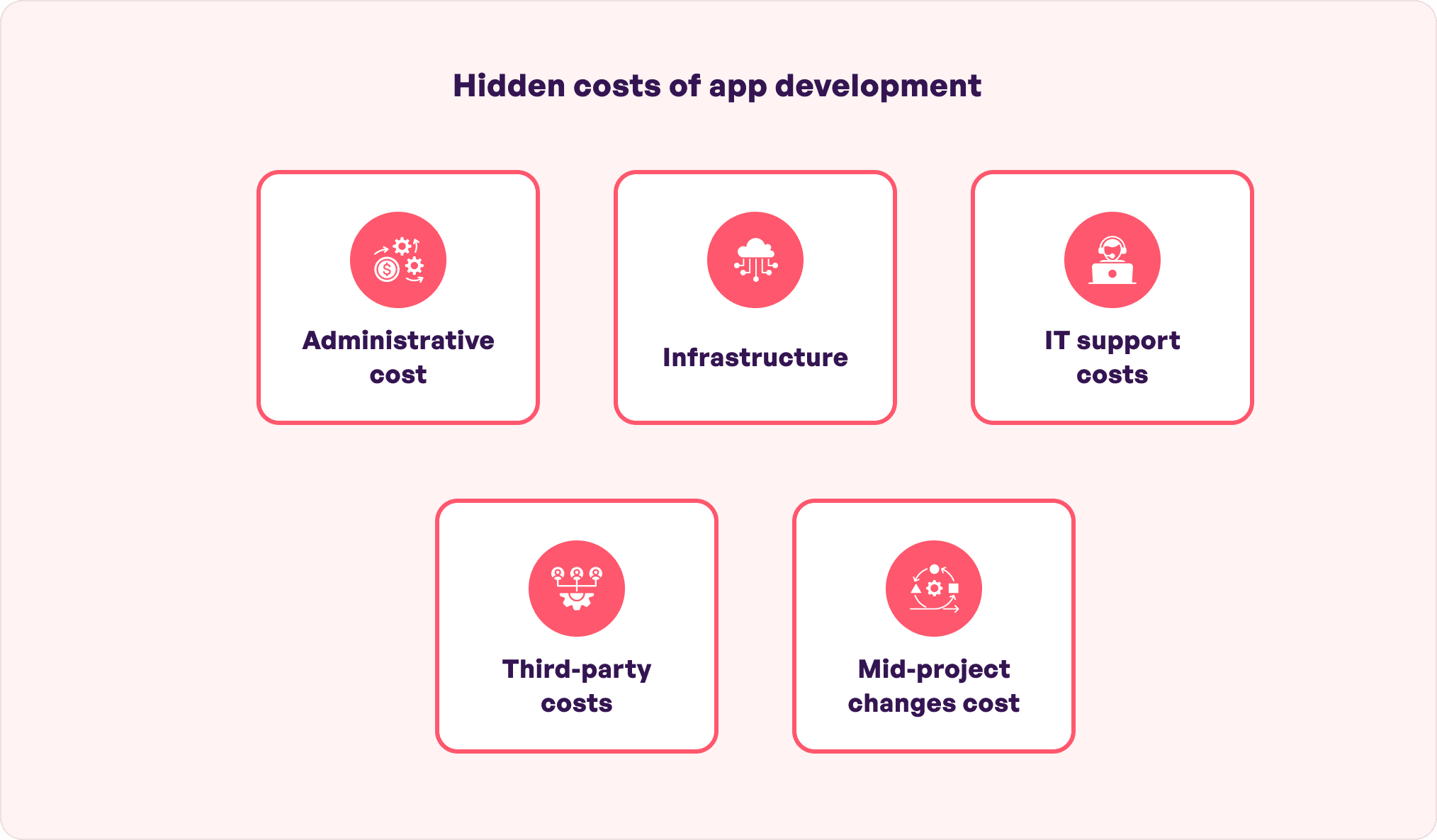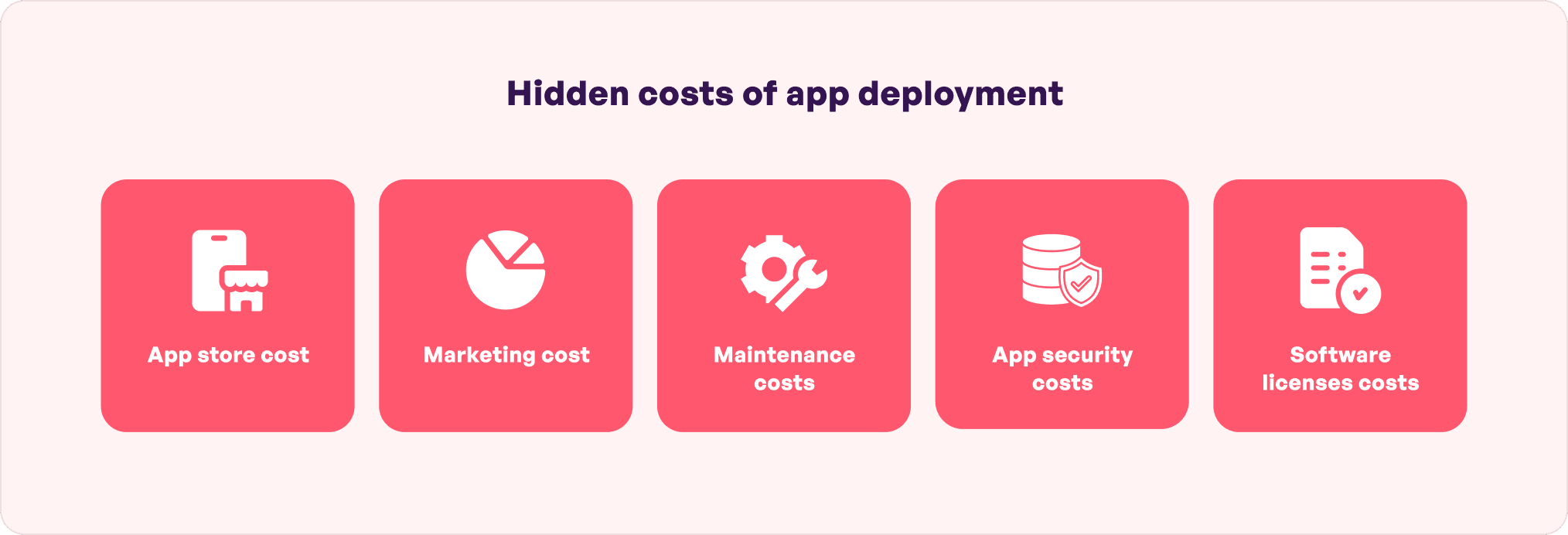The inception of apps took place with the built-in version of the game ‘Snake’ which was launched in 1997 by Nokia 6110 when mobile phones were only finding their user base. Since then, technology has come a long way, leading to the surge of powerful apps that act as mediators of our interactions with the physical world. So, it is no surprise that mobile applications are expected to generate over $935 billion by the end of 2024 powered by promising advancements with AI, ML, IoT, blockchain, AR and VR integrations.
Investing in the development of best-in-class mobile apps is undoubtedly a lucrative move for any business. However, while the costs of app development is usually straightforward, what cannot be overlooked is the unexpected hidden expenses. These are not typically covered in the quoted value but might pop up later. So, a limited or zero clue of the non-visible prices can cause financial surprises and hiccups in the app development journey.
This inconvenience is exactly what our in-house team at Simublade strives to avoid by ensuring complete transparency when it comes to service expenses. We ensure our customers have end-to-end cost clarity and are never in the dark. So, this article caters to the issues of hidden costs of mobile app development by offering an in-depth understanding to help make informed budget decisions. Read on to find out more.
Table of contents
The 5 hidden costs of developing an app
In this section, let us see the hidden mobile app development costs that must be considered in the budget before kick-starting the project.

1. Administrative costs
This consists of proper documentation, time tracking, communication tools like Zoom, project management, dashboard emulators, data segmentation, content management tools like WordPress, and access controls which altogether offer refined and updated user data. The overall expenses of these parameters apply to all app types and are hard to predict and might increase or decrease depending on the project complexity.
2. Infrastructure costs
Data storage, data delivery, environment for development, testing, and production, servers, integration and deployment tools (CI/CD) need continuous monitoring and optimization for all types of mobile apps. For these, businesses need to pay for prototype expenses, purchased SDKs and APIs, and project collaboration tools. Further, security and backup are also covered in infrastructure expenses which might shoot up the cost of developing an app.
3. IT support costs
The quality of any application would be compromised without robust technical support which consists of API maintenance, bug fixing, iOS and Android updates, and Tapp update submissions. Further, tools like Mixpanel, Stripe, and AWS are also required. Put together, these can incur additional costs on the development front. Businesses are also charged for server/cloud hosting, ongoing security auditing, cybersecurity disaster recovery, growth support, and CDN for speed optimization.
4. Third-party costs
Third-party integrations are important for particular apps like payment getaways, geolocations and analytics and services like OTP notifications and emails to work flawlessly. There are countless integrations like APIs and SDKs which can push the cost of developing an app higher. Businesses end up paying hefty amounts for their set up, licenses and usage charges align with on-going payments later on. However, these are significantly less than building integrations from scratch.
5. Mid-project changes costs
All mobile app development cost estimations are typically based on the initial product roadmap, discovery workshop, or the design sprint sessions. So, there are high chances for the expenses to get altered throughout the project due to different UI/UX design, new integrations, extra features, and changing technologies. While most businesses are well-aware that these are evident, chances are, they do not realize that the costs can exceed much beyond their assumptions of the hidden cost of mobile app development.
Top 5 hidden costs of deploying an app
A few extra amounts also come up when deploying the mobile application on multiple platforms So, watch out for these unexpected costs to be able to spare some extra budget and avoid money crunch.

1. App store costs
Publishing apps on Google Play Store and App Store are chargeable. Here’s a breakdown:
- Google Play Store charges a one time fee of $25.
- Apple Store charges $99 per year.
- 15% to 30% of business income from digital goods needs to be paid to the Google Play Store if your apps have in-app purchases or subscriptions.
- 30% of the transactions need to be paid to the App Store if your app is paid or has in-app purchases. If your business earns less than $1 million, the rate is 15% under the Small Business Program.
While these are fair, not all apps are permitted to be launched if they fail the approval check due to quality or store compliance issues. Do add this expense since this can increase the average cost to develop an app because the standards and rules of Google Play Store and App Store keep changing and businesses need to update both native and cross-platform apps to continue doing business.
2. Marketing costs
Rigorous marketing is a mandate after the app goes live to make sure the audience is aware that you exist. This is a critical factor for brand awareness, revenue, and competitive edge which altogether contribute to make or break a mobile or web application. The standard promotional activities are:
- press releases
- app store optimization
- digital advertisements
- email-marketing
- social media campaigns
- influencer collaborations.
These can altogether cost you anywhere between $1,000 to $2,000. To top this, additional support might be required to meet user acquisition targets.
3. Maintenance costs
Post-launch app maintenance costs typically means developers fees for fixing bugs and applying security patches, verifying compatibility, and adding new features. Further, it is also necessary to upgrade to the latest operating systems. For instance, Apple integrated ‘Dynamic Island’ in iPhone 14 Pro and released iOS version 16, which means, apps must be updated accordingly to match the changing demands of customers.
Besides these, proactive maintenance for technical debts at regular intervals are necessary to ensure the application is competitive and effective. So, a general guideline for the first year is to keep aside at least 40% of the initial mobile app development cost budget to fund the maintenance needs. Later, it might come down to 15%- 20% annually.
4. App security costs
An app must be in compliance with consumer data privacy laws like HIPAA, COPPA, U.S. Privacy Act of 1974, and Gramm-Leach-Bliley Act to ensure data safety. Doing so can be quite complex and costly since each one has specific requirements.
Further, regular audits, two-factor authentications, and encryption are crucial to avoid cyberattacks or vulnerability exposure. Overall, considering a security budget is no less than an investment since it helps build trust and credibility among end-users.
5. Software licenses costs
Businesses need to pay for particular APIs, SDKs, development tools, or libraries. These can exceed budgets enormously and must be considered during the app development cost breakdown process. Here’s an idea of what all are included in software licenses:
- Map integration licenses for apps like Google Maps
- Payment gateway fees (roughly $25 per month)
- Google Play developer API fees
Sometimes, businesses might need a license for every person using particular development programs while certain libraries work on usage-based fees. Due to these, the cost of developing an app might go through the ceiling.
The good news at this point is that Simublade, a trusted mobile app development company, offers everything from new-gen tech stack to multiple languages, tools and frameworks for smooth engineering, product design, deployment and launch. Our developers discuss each of the above factors while calculating the final app development and maintenance costs to ensure you never have initial and final budget discrepancies.
How to reduce the hidden mobile app development cost?
It is necessary to have logical strategies in place that can successfully prevent resource bleeding due to spiraling costs that were not initially upfront. Here’s a look:
Honest dedicated app developers
Hire developers who conduct a proper discovery workshop, suggest a design sprint session, and create a product roadmap to be able to explore the best app development option for your business that does not burn your pockets. They give you a crystal clear understanding of project expenses including the hidden ones. Further, the developers also provide the MVP development costs to provide a rough idea of the expenses to expect.
Define the project scope
Finalize the scope of the application, its core features and UI/UX designs after collaborating with the team of developers and designers. The process must encompass:
- concept brainstorming
- understanding the target audience
- researching competitors
- visualizing the app idea
- selecting the tech stack and tools
Once the entire concept is ready, there are fewer chances of mid-project changes which helps save a chunk of your budget.
Consider an MVP
Minimum viable products allow for experiments with features, functionalities, designs, and tech-stack while providing a glimpse into the development process. In fact, the best MVP service also includes refining your idea from market and technical angles to prevent the fear of zero acceptance. So, there is a control on the expenses and chances of budget reduction when certain tools or technologies prove to be less important than initially expected.
Avoid technical debt
The best developers, like the ones at Simublade, avoid technical debts, which means taking shortcuts to write codes and tick off goals faster which later ends up in extensive refactoring. Our team avoids such hacks and invests enough time and patience to write clean codes for robust functionality. It is of primary importance since tech debts amount to 20% to 40% of the entire technology state of organizations.
Step-by-step approach
Ticking off small milestones bit by bit instead of completing an entire service at once can be helpful to avoid wastage of time and money. For instance, adept developers typically conduct security testing part by part and check their success rate instead of testing as a one time project. This step helps to avoid mistakes and reworks.
Conclusion
A considerable part of the cost of app development comprises the hidden charges. However, being well-prepared with an understanding of expenses can help you make smart decisions and utilize resources efficiently.
Further, try to ease the app complexity, if possible to avoid extra charges. For instance, a simple app does not need robust security whereas fintech or retail apps with payment getaways or geo locations generally require heavy safety features which shoots up the security expenses. Cross-platform apps do not require frequent upgrades whereas native apps need to stay updated to the latest versions of the operating systems which increase maintenance costs.
So, work closely with our team of developers at Simublade who can help you with budget-friendly yet less-complex options without hampering the quality, functionality, or aesthetics of your business application.
FAQs
Q. How much does it cost to develop an app?
Ans. The average cost to develop an app is between $25,000 to $150,000 and can go up to $300,000. It will depend on the features, functionalities, tech-stack, development approaches and complexities.
Q. How to reduce mobile app development cost?
Ans. Ways to reduce app development cost include providing requirements in details, simple features, technologies and UI/UX designs, and considering product roadmaps and MVPs before getting a full-fledged app built.
Q. How much does app maintenance cost?
Ans. Generally, app maintenance costs are between $250 to $500 every month. Businesses must put aside 40% of the initial development budget for maintenance in the first year which later comes down to 15% to 20%.





